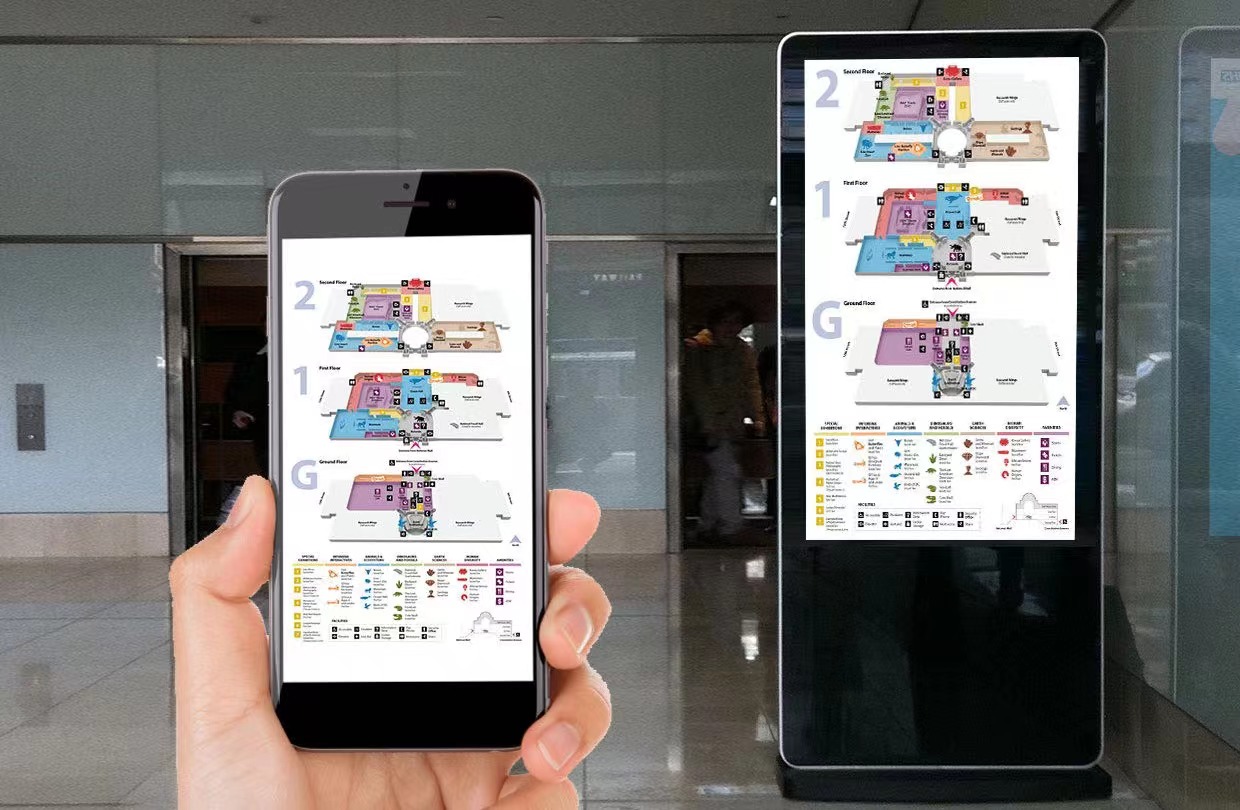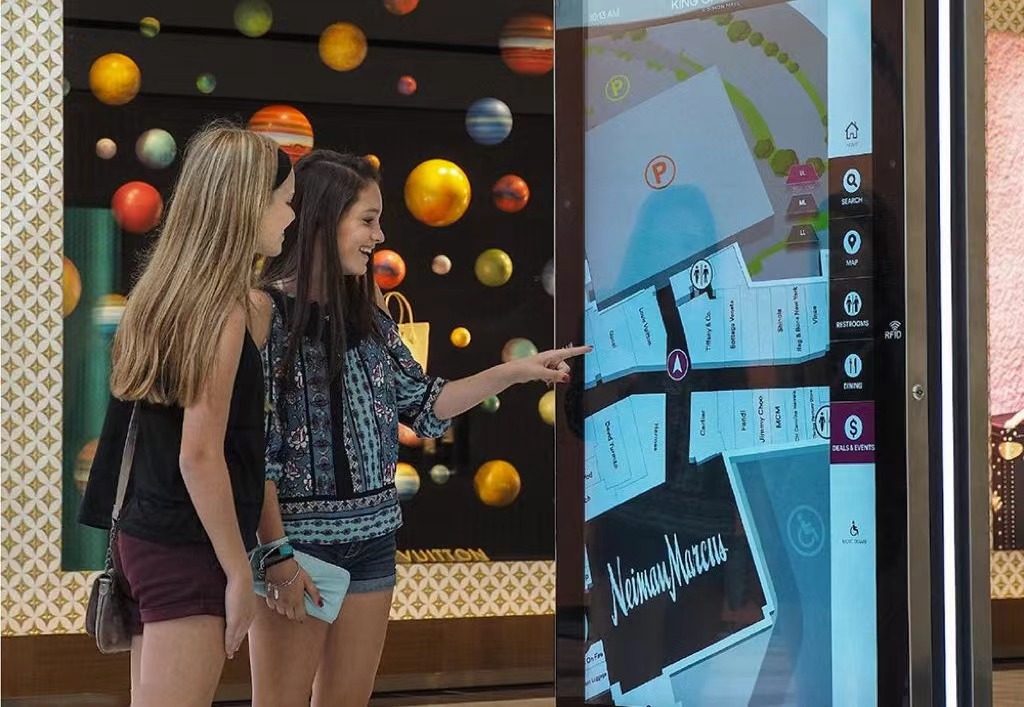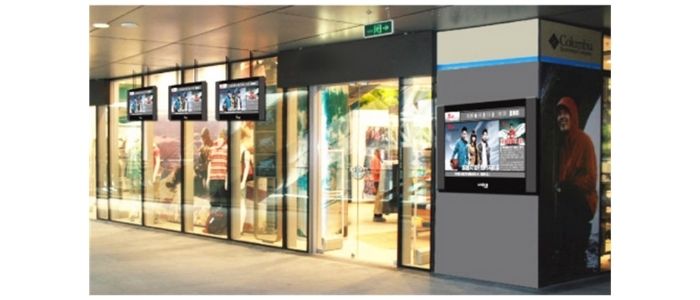In recent years, the widespread adoption and integration of digital technology have propelled the rapid advancement of smart cities, introducing numerous innovations that significantly impact people’s lives. Integral to this progress is the emergence and influence of interactive digital signage. This contemporary media concept not only facilitates interaction between individuals and the smart city but also serves as a crucial information portal, shaping people’s perceptions of the world. In the ongoing process of urban intellectualization, interactive digital signage plays an indispensable role
What is Interactive Digital Signage?
While personalization has been a trending focus in digital marketing over recent years, if personalization truly represents the future of business, then interactive digital signage emerges as the linchpin to that future. Positioned as one of the most potent marketing tools available, interactive digital signage consistently prioritizes the viewer’s experience.
By enticing viewers to engage with screen content and discover pertinent information tailored to their needs, interactive digital signage transforms traditional advertising into an immersive and participatory experience. Distinguishing itself from conventional digital signage, interactive digital signage proactively delivers information through the incorporation of technologies such as multi-touch functionality, image recognition, augmented reality, human-computer interaction process tracking, and gesture remote control.
This rich amalgamation of interactive technologies lends a captivating and interesting expression to the content, encouraging the audience to actively engage in one-on-one interactive communication and markedly improving the precision of information dissemination.

Why should Digital Signage be Interactive?
In today’s urban landscape, the average city dweller encounters a multitude of digital displays daily, the majority of which lack interactive features. Integrating interactivity often involves additional technology and setup costs, which are typically shouldered by media operators seeking to enhance the functionality of their signage and advertisers investing in more sophisticated campaigns. Is the additional investment in interactive signage justified?
The answer hinges on the memorability of interactive signage in a cluttered advertising environment. MAGNA reports that interactive video ads enjoy a 47% longer viewing duration compared to non-interactive ads, and consumers are more likely to be impressed by interactive ads, regardless of whether they actively engage.
Unlike traditional advertising displays, the digital interactive era empowers consumers to independently access information, fostering more targeted and autonomous consumer behavior. This shift is highly valued by companies, enabling real-time measurement of advertising effectiveness and insight into audience preferences and consumption habits. The key to this lies in the creation of more innovative and engaging content that is precise and aligns with consumer needs, encouraging participation and sharing.
As technological advancements continue, the future of interactive digital signage is poised to be more proactive in information dissemination. The integration of technologies such as multi-touch functionality, image recognition, augmented reality, human-computer interaction process tracking, and gesture remote control will result in more captivating and expressive forms of content, enhancing both interest and information accuracy.
Interactive digital signage transforms advertising from an annoying nuisance into an experience that caters to consumer needs, allowing people to actively engage. As high-end buyers seek ways to make their advertisements stand out, only an interactive digital network that meets their expectations will maintain a competitive advantage.

What are the Types of Interaction in Digital Signage?
Interactive digital signage is a diverse concept that manifests differently across various programs. Before delving into the preferred “types of interaction” by users, let’s explore some common forms of interaction.
1, Touch
Touchscreens are a prevalent form of interaction in digital signage. With the simplicity of engagement—allowing individuals to interact by merely approaching the device—touchscreens have become ubiquitous and a reliable choice. They are frequently employed to enable audiences to navigate information on the screen or manipulate various elements.
Some common applications of interactive digital signage touch screens include:
- Wayfinding digital signage
- Self-service kiosks
- Visitor management
- Special advertisements
- Digital product catalogs
- Discount and offer announcements
- Digital menu boards
Interactive Signage Examples: The Arneg showroom greets visitors with uniquely designed interactive digital signage facilitating map viewing, access point identification, and exploration of photo and video galleries—all through touchscreen interaction. The brand seamlessly integrates interactive digital wayfinding with information and entertainment, creating an unforgettable experience for visitors. Let’s delve into how they achieve this objective.
2. Gesture/Motion Tracking
Gesture control, akin to the touch screen method but with added flair and reduced precision, allows individuals to approach a sign and make gestures. A camera on the device records the type and speed of the gesture, triggering a corresponding screen response.
Video gesture control technology enables users to interact with multimedia content, offering an immersive experience, including 3D interactions. Users move from one position to another based on the commands or activity levels displayed on the screen, facilitating access, manipulation, and engagement with the available content.
Common Occasions:
- In-store interactive shopping
- Gaming and infotainment
- Retail entertainment
- Theme park entertainment
- Museum exhibits
- Innovative promotions
Interactive Signage Examples: Nestle challenged traditional product marketing norms to promote their Cold Brew Coffee in Shanghai Metro stations. Interactive digital screens with motion sensor technology allowed users to play engaging games and win a complimentary bottle of the newly launched coffee variety. Discover more about their innovative approach:
3. QR Code
While QR codes represent a more passive form of interaction, they are widely employed in various industries within interactive digital signage. QR codes facilitate the easy sharing of brand information, product listings, catalogs, restaurant menus, web pages, wayfinding maps, service details, and other valuable content on interactive digital screens.
Common Uses: Wayfinding, Information, and Website Sharing
Interactive Signage Examples: Explore this interactive campaign by Olympe aimed at promoting their musical instruments and discovering new possibilities through QR code interaction.
4. Augmented Reality and Visual Recognition
Engaging through AR, augmented reality-driven interactivity enables brands to merge the viewer’s artificial and real environments, creating captivating experiences. To truly grasp the excitement and entertainment it offers to your audience, it’s best to witness how it works firsthand. Watch the video below for a demonstration of common uses.
Achieving effective augmented reality advertising involves installing a camera beside a digital display and connecting it to a compatible computer. This playful method can generate an entirely new experience for both the bystander and the surrounding world. Another application includes basic visual recognition using a camera to deliver customized messages based on the audience’s demographic. For instance, the advertisement will display different content depending on whether the audience consists of adults or children.
Common Uses: AR, Motion Ads
Interactive Signage Examples: JCDecaux and Telia Estonia promoted the launch of a new TV channel called “Inspira” with Estonia’s first outdoor AR campaign. With 10% of Estonians tuning in to the new channel within the first month, it’s safe to say that the campaign had a positive impact.
How to Choose Between Interactive and Non-Interactive Digital Signage?
With the increasing reliance on mobile devices for information, people have grown accustomed to interacting with screens to access instant information. Consequently, businesses and organizations are inclined to adopt digital signage due to its flexibility, data collection capabilities, and higher return on investment compared to traditional signage. However, the decision to invest in digital signage requires careful consideration, specifically whether to opt for interactive or non-interactive digital signage to effectively reach target consumers.
Before deciding on the most suitable option, it’s crucial to understand the differences between these two types of digital signage and what each offers:
- Who is the target consumer?
- What do you want them to know or do?
- Where will the digital signage be set up?
- When will the target consumers see the digital signage?
- How will you measure its effectiveness?
Both interactive and non-interactive digital signage support various content formats (video, images, text, or audio).
Content scaling and sequencing can be controlled through digital signage software.
Remote content editing and analytics for data tracking are possible.
Considering these common features, there are three main differences to consider:
- Cost: Non-interactive digital signage is generally less expensive than interactive signage. Interactive signage involves touchscreens and more complex software, leading to higher costs.
- Maintenance: Interactive digital signage may require a more in-depth design and development phase, resulting in increased maintenance needs.
- User Interaction: Non-interactive signage is suitable for sedentary or standing audiences (e.g., waiting areas, offices, airports).
Interactive signage engages users, allowing them to search for and access information instantly, ideal for locations where quick interaction is essential.
Ultimately, the choice depends on the usage context and goals. Non-interactive signage is suitable for locations where viewers are stationary, while interactive signage is preferred when engagement and quick access to information are priorities, such as answering questions, giving directions, or providing information to users in a hurry.
As the cost of interactive technology decreases and its adoption becomes more prevalent, interactivity is poised to evolve from a luxury to a necessity in digital industry network operations. Investing in the right technology can pave the way for efficient growth for network owners and their businesses for years to come.
Are you considering establishing an interactive digital signage network? Request a demo to explore how we can assist you.






